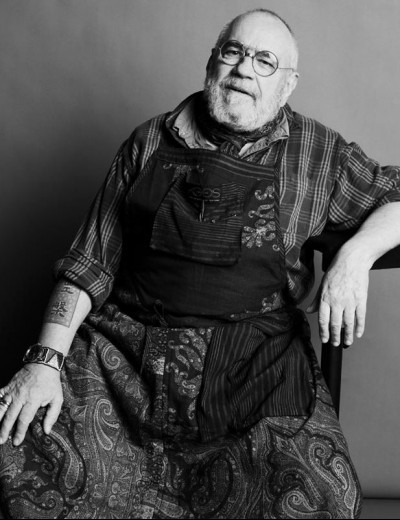
Koos Van Den Akker
About
Koos van den Akker was born in 1939, in the Hague, Netherlands. In 1955 he studied at the Royal Academy of Art in the Hague.
His first work in fashion was with Christian Dior in Paris, but he returned to Holland and opened his own boutique, around 1960.
In 1968, carrying a portable sewing machine, he moved to the USA and set up a temporary shop on a Manhattan pavement, which attracted a great deal of attention. His first designs were quilted garments with inserts of lace.
By 1970 he had opened the first of several stores in New York city. Taking his inspiration from fabric, Van den Akker created clothes that are highly individual and boldly coloured, using collage and patchwork. Selling his own custom-made dresses in a boutique gained van den Akker enough experience to open a Madison Avenue shop, one in Beverly Hills, and a men's boutique during the 1970s. In 1983 he presented a moderately priced collection, Hot House. By 1986 he was designing lingerie, daytime and evening clothes, furs, sheets, and home furnishings. Women's clothes were made of beautiful fabrics with colorful print and lace inserts, sometimes following the lines of the garments in harmony and balance, other times contrasting shapes versus line.
Van den Akker's moment has again come, his dresses from decades ago are being worn by Hollywood celebrities to important occasions. He is also making new designs today, using his signature collage and appliqué techniques.
To adoring fans of his designs, van den Akker sold all of his fall-winter 1998 collection in 27 minutes. Finding homes in closets were a big shirt, reversible silk jacket, bias patchwork skirt, pull-cord handbag, and comfy drawstring pants with cotton tee.
Koos designs his Koos of Course line for QVC and is a favourite of customers, wearing his signature apron and dishing out fashion advice.
The Look
Koos van den Akker is known for his painterly delight in mixing colors, patterns, and textures in unusual, often one of a kind, garments. Since his arrival in the United States in 1968 with just a sewing machine, he has been delighting clients who want something a bit different to wear. His styles have not changed much, simple shapes being more amenable to rich surface manipulations. Having learned the basics of good fit and cut as an apprentice with the house of Christian Dior, van den Akker was able to proceed confidently with the fabric collages that have become his signature. Although his Koos garments recall the art-to-wear movement, they remain free of the sometimes heavy-handed messages inherent in the artifacts which seem more suitable for gallery walls—these masterpieces are meant to be worn and appreciated for their beauty. Conservatively styled suits consisting of cardigan jackets and gored skirts might be covered with textured mixtures of fur, quilted fabric, leather strips, or pieces of wool. A dress of lace might be dramatized by bold appliqué. As many as six materials might be combined in collages of cotton, wool, furs, tweeds, sequins, and leather. Some of the results are reminiscent of grandmother's crazy quilt, but all are carried out with a true designer's skill and artistic sensitivity. Indeed, van den Akker has admitted that the designs just flow, working themselves out through the process of creation, perhaps reflecting a hereditary affinity with Dutch national costume. In late 1989 van den Akker showed the home-sewing public how to make their own creative clothing in a detailed article in Threads Magazine. The next year signaled a broadening of his range to include simpler ready-to-wear sportswear—tweed dresses and coats, coats of blanket materials, matching suede jackets and skirts, and short floral dresses with just a hint of the Koos play with fabrics in a mixed-print collar. The designer continued to refine his artistry, developing a ready-to-wear sportswear collection for DeWilde that is more subtle and interchangeable. Toned-down collage effects and texture appliqués lend interest to classic pieces in wool and cashmere, even sheer georgette. Throughout the last months of the 20th century and into the 21st, while collectors were stocking their wardrobes with his past glories, van den Akker remained a fashion pacesetter. He served as one of four guest critics of future fashion designers at the Fashion Institute of Technology exhibit entitled White Noise. The 1999 segment of the spirited annual student show at Marist College in Poughkeepsie, New York, interpreted the psychological concept of white noise with 30 garments for adults and children. Despite PETA's protests of his use of fur in coutourier collections, he, along with Oscar de la Renta and Valentino, continued to design for New York-based furrier Alixandre by applying broadtail, fox, lynx, mink, sable, and sheared beaver to winter fashions. Van den Akker's spring/summer line for 2001 perpetuated his tradition of fabric collage and appliquéd couture in softly draping shapes to flatter the figure.
Who Wears It
Gloria Vanderbilt, Elizabeth Taylor, Cher, Barbara Walters, Glenn Close, Bill Cosby